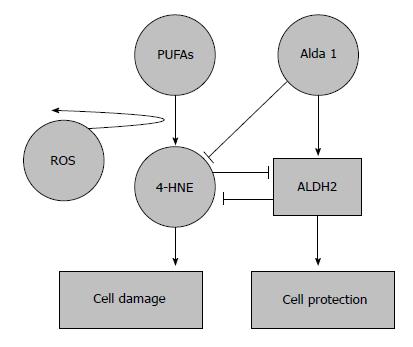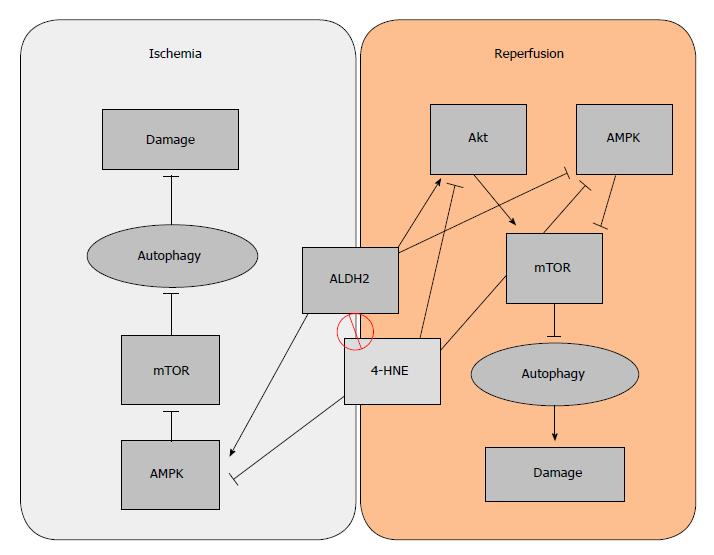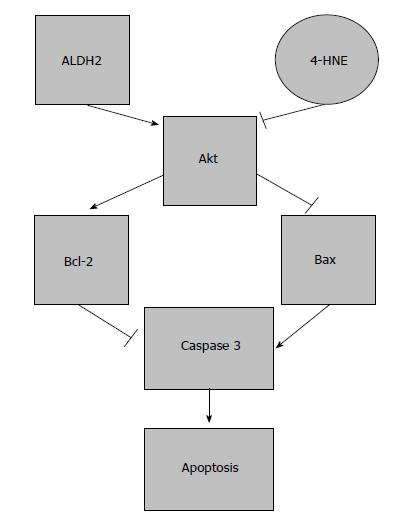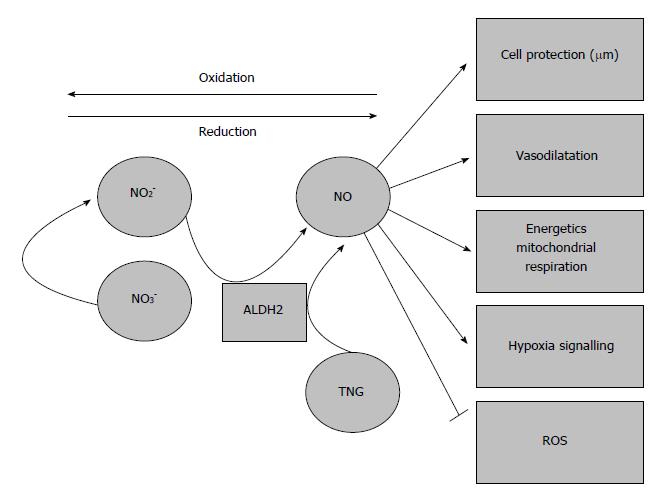Copyright
©The Author(s) 2018.
World J Gastroenterol. Jul 21, 2018; 24(27): 2984-2994
Published online Jul 21, 2018. doi: 10.3748/wjg.v24.i27.2984
Published online Jul 21, 2018. doi: 10.3748/wjg.v24.i27.2984
Figure 1 Protective effects of aldehyde dehydrogenase 2 on 4-hydroxy-2-nonenal accumulation in ischemia reperfusion injury.
4-hydroxy-2-nonenal (4-HNE) is a pivotal marker for cell damage associated with oxidative stress; its accumulation is prevented by aldehyde dehydrogenase 2 (ALDH2) activation and the action of its agonists. An overwhelming 4-HNE accumulation may also inhibit ALDH2 action. 4-HNE: 4-hydroxy-2-nonenal.
Figure 2 Dual regulatory effect of aldehyde dehydrogenase 2 (ALDH2) on autophagy.
During ischemia, AMPK is activated to promote “cytoprotective” autophagy due to mTOR inhibition. On the other hand, the activation of Akt during the phase of reperfusion inhibits “deleterious” autophagy, which is associated with apoptosis, thus reducing organ damage.
Figure 3 Effects of aldehyde dehydrogenase 2 on apoptosis in ischemia reperfusion injury.
Protection induced by aldehyde dehydrogenase 2 (ALDH2) on apoptosis. The balance between ALDH2/4-HNE is responsible for the modulation of apoptosis through Akt and caspase 3 expression.
Figure 4 Aldehyde dehydrogenase 2 and vasodilation due to nitrates/nitrites/nitric oxide generation.
The generation of nitric oxide from nitrates/nitrites and its vasodilatory properties may contribute to prevent the deleterious effects of ischemia-reperfusion injury. ALDH2: Aldehyde dehydrogenase 2.
Figure 5 Aldehyde dehydrogenase 2 and 4-hydroxy-2-nonenal balance in ischemia reperfusion injury.
Red areas represent damage, whereas green ones depict protection of the cell through the various mechanisms. ALDH2: Aldehyde dehydrogenase 2; 4-HNE: 4-hydroxy-2-nonenal.
- Citation: Panisello-Roselló A, Lopez A, Folch-Puy E, Carbonell T, Rolo A, Palmeira C, Adam R, Net M, Roselló-Catafau J. Role of aldehyde dehydrogenase 2 in ischemia reperfusion injury: An update. World J Gastroenterol 2018; 24(27): 2984-2994
- URL: https://www.wjgnet.com/1007-9327/full/v24/i27/2984.htm
- DOI: https://dx.doi.org/10.3748/wjg.v24.i27.2984

















